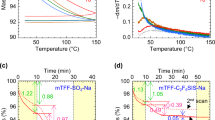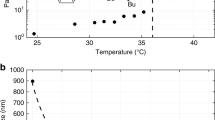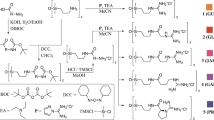Abstract
Weakly hydrated anions help to solubilize hydrophobic macromolecules in aqueous solutions, but small molecules comprising the same chemical constituents precipitate out when exposed to these ions. Here, this apparent contradiction is resolved by systematically investigating the interactions of NaSCN with polyethylene oxide oligomers and polymers of varying molecular weight. A combination of spectroscopic and computational results reveals that SCN− accumulates near the surface of polymers, but is excluded from monomers. This occurs because SCN− preferentially binds to the centre of macromolecular chains, where the local water hydrogen-bonding network is disrupted. These findings suggest a link between ion-specific effects and theories addressing how hydrophobic hydration is modulated by the size and shape of a hydrophobic entity.

This is a preview of subscription content, access via your institution
Access options
Access Nature and 54 other Nature Portfolio journals
Get Nature+, our best-value online-access subscription
$29.99 / 30 days
cancel any time
Subscribe to this journal
Receive 12 print issues and online access
$259.00 per year
only $21.58 per issue
Buy this article
- Purchase on Springer Link
- Instant access to full article PDF
Prices may be subject to local taxes which are calculated during checkout




Similar content being viewed by others
Data availability
The datasets generated during and/or analysed during the current study are available via the following DOIs: Fig. 2, https://doi.org/10.5281/zenodo.5123016; Fig. 3, https://doi.org/10.5281/zenodo.5123100; Fig. 4, https://doi.org/10.5281/zenodo.5123104. Source data are provided with this paper. Source data for the Supplementary figures are available at https://doi.org/10.5281/zenodo.5123295.
Code availability
The codes and algorithms generated during the current study are available from the corresponding author on reasonable request.
References
Bye, J. W. & Falconer, R. J. Thermal stability of lysozyme as a function of ion concentration: a reappraisal of the relationship between the Hofmeister series and protein stability. Protein Sci. 22, 1563–1570 (2013).
Gibb, C. L. D. & Gibb, B. C. Anion binding to hydrophobic concavity is central to the salting-in effects of Hofmeister chaotropes. J. Am. Chem. Soc. 133, 7344–7347 (2011).
Ray, A. & Nemethy, G. Effects of ionic protein denaturants on micelle formation by nonionic detergents. J. Am. Chem. Soc. 93, 6787–6793 (1971).
Zhang, Y. & Cremer, P. S. Interactions between macromolecules and ions: the Hofmeister series. Curr. Opin. Chem. Biol. 10, 658–663 (2006).
Petersen, P. B. & Saykally, R. J. On the nature of ions at the liquid water surface. Annu. Rev. Phys. Chem. 57, 333–364 (2006).
Tobias, D. J. & Hemminger, J. C. Getting specific about specific ion effects. Science 319, 1197–1198 (2008).
Pegram, L. M. & Record, M. T. Thermodynamic origin of Hofmeister ion effects. J. Phys. Chem. B 112, 9428–9436 (2008).
Zhang, Y. & Cremer, P. S. Chemistry of Hofmeister anions and osmolytes. Annu. Rev. Phys. Chem. 61, 63–83 (2010).
Lo Nostro, P. & Ninham, B. W. Hofmeister phenomena: an update on ion specificity in biology. Chem. Rev. 112, 2286–2322 (2012).
Okur, H. I. et al. Beyond the Hofmeister series: ion-specific effects on proteins and their biological functions. J. Phys. Chem. B 121, 1997–2014 (2017).
Zhang, Y., Furyk, S., Bergbreiter, D. E. & Cremer, P. S. Specific ion effects on the water solubility of macromolecules: PNIPAM and the Hofmeister series. J. Am. Chem. Soc. 127, 14505–14510 (2005).
Cho, Y. et al. Effects of Hofmeister anions on the phase transition temperature of elastin-like polypeptides. J. Phys. Chem. B 112, 13765–13771 (2008).
Rembert, K. B. et al. Molecular mechanisms of ion-specific effects on proteins. J. Am. Chem. Soc. 134, 10039–10046 (2012).
Rembert, K. B., Okur, H. I., Hilty, C. & Cremer, P. S. An NH moiety is not required for anion binding to amides in aqueous solution. Langmuir 31, 3459–3464 (2015).
Dang, L. X. Computational study of ion binding to the liquid interface of water. J. Phys. Chem. B 106, 10388–10394 (2002).
Jungwirth, P. & Tobias, D. J. Ions at the air/water interface. J. Phys. Chem. B 106, 6361–6373 (2002).
Petersen, P. B., Saykally, R. J., Mucha, M. & Jungwirth, P. Enhanced concentration of polarizable anions at the liquid water surface: SHG spectroscopy and MD simulations of sodium thiocyanide. J. Phys. Chem. B 109, 10915–10921 (2005).
Otten, D. E., Shaffer, P. R., Geissler, P. L. & Saykally, R. J. Elucidating the mechanism of selective ion adsorption to the liquid water surface. Proc. Natl Acad. Sci. USA 109, 701–705 (2012).
Fox, J. M. et al. Interactions between Hofmeister anions and the binding pocket of a protein. J. Am. Chem. Soc. 137, 3859–3866 (2015).
McCaffrey, D. L. et al. Mechanism of ion adsorption to aqueous interfaces: graphene/water vs. air/water. Proc. Natl Acad. Sci. USA 114, 13369–13373 (2017).
Sokkalingam, P., Shraberg, J., Rick, S. W. & Gibb, B. C. Binding hydrated anions with hydrophobic pockets. J. Am. Chem. Soc. 138, 48–51 (2016).
Sullivan, M. R., Yao, W., Tang, D., Ashbaugh, H. S. & Gibb, B. C. The thermodynamics of anion complexation to nonpolar pockets. J. Phys. Chem. B 122, 1702–1713 (2018).
Rankin, B. M. & Ben-Amotz, D. Expulsion of ions from hydrophobic hydration shells. J. Am. Chem. Soc. 135, 8818–8821 (2013).
Balos, V., Kim, H., Bonn, M. & Hunger, J. Dissecting Hofmeister effects: direct anion–amide interactions are weaker than cation–amide binding. Angew. Chem. Int. Ed. 55, 8125–8128 (2016).
Long, F. A. & McDevit, W. F. Activity coefficients of nonelectrolyte solutes in aqueous salt solutions. Chem. Rev. 51, 119–169 (1952).
Stillinger, F. H. Structure in aqueous solutions of nonpolar solutes from the standpoint of scaled-particle theory. J. Solution Chem. 2, 141–158 (1973).
Chandler, D. Interfaces and the driving force of hydrophobic assembly. Nature 437, 640–647 (2005).
Davis, J. G., Gierszal, K. P., Wang, P. & Ben-Amotz, D. Water structural transformation at molecular hydrophobic interfaces. Nature 491, 582–585 (2012).
Hande, V. R. & Chakrabarty, S. Structural order of water molecules around hydrophobic solutes: length-scale dependence and solute–solvent coupling. J. Phys. Chem. B 119, 11346–11357 (2015).
Pierce, V., Kang, M., Aburi, M., Weerasinghe, S. & Smith, P. E. Recent applications of Kirkwood–Buff theory to biological systems. Cell Biochem. Biophys. 50, 1–22 (2008).
Knowles, D. B. et al. Chemical interactions of polyethylene glycols (PEGs) and glycerol with protein functional groups: applications to effects of PEG and glycerol on protein processes. Biochemistry 54, 3528–3542 (2015).
Fega, K. R., Wilcox, A. S. & Ben-Amotz, D. Application of Raman multivariate curve resolution to solvation-shell spectroscopy. Appl. Spectrosc. 66, 282–288 (2012).
Walrafen, G. E., Fisher, M. R., Hokmabadi, M. S. & Yang, W. ‐H. Temperature dependence of the low- and high-frequency Raman scattering from liquid water. J. Chem. Phys. 85, 6970–6982 (1986).
D’Arrigo, G., Maisano, G., Mallamace, F., Migliardo, P. & Wanderlingh, F. Raman scattering and structure of normal and supercooled water. J. Chem. Phys. 75, 4264–4270 (1981).
Sun, Q. Local statistical interpretation for water structure. Chem. Phys. Lett. 568–569, 90–94 (2013).
Harada, Y. et al. Probing the OH stretch in different local environments in liquid water. J. Phys. Chem. Lett. 8, 5487–5491 (2017).
Morawietz, T. et al. The interplay of structure and dynamics in the Raman spectrum of liquid water over the full frequency and temperature range. J. Phys. Chem. Lett. 9, 851–857 (2018).
Duboué-Dijon, E. & Laage, D. Characterization of the local structure in liquid water by various order parameters. J. Phys. Chem. B 119, 8406–8418 (2015).
Mackay, D. & Shiu, W. Y. A critical review of Henry’s Law constants for chemicals of environmental interest. J. Phys. Chem. Ref. Data 10, 1175–1199 (1981).
Meyer, D. E. & Chilkoti, A. Quantification of the effects of chain length and concentration on the thermal behavior of elastin-like polypeptides. Biomacromolecules 5, 846–851 (2004).
Lee, C., McCammon, J. A. & Rossky, P. J. The structure of liquid water at an extended hydrophobic surface. J. Chem. Phys. 80, 4448–4455 (1984).
Lum, K., Chandler, D. & Weeks, J. D. Hydrophobicity at small and large length scales. J. Phys. Chem. B 103, 4570–4577 (1999).
Laage, D., Stirnemann, G. & Hynes, J. T. Why water reorientation slows without iceberg formation around hydrophobic solutes. J. Phys. Chem. B 113, 2428–2435 (2009).
Petersen, C., Tielrooij, K.-J. & Bakker, H. J. Strong temperature dependence of water reorientation in hydrophobic hydration shells. J. Chem. Phys. 130, 214511 (2009).
Xi, E. et al. Hydrophobicity of proteins and nanostructured solutes is governed by topographical and chemical context. Proc. Natl Acad. Sci. USA 114, 13345–13350 (2017).
Li, I. T. S. & Walker, G. C. Signature of hydrophobic hydration in a single polymer. Proc. Natl Acad. Sci. USA 108, 16527–16532 (2011).
von Hippel, P. H. & Wong, K.-Y. On the conformational stability of globular proteins. The effects of various electrolytes and nonelectrolytes on the thermal ribonuclease transition. J. Biol. Chem. 240, 3909–3923 (1965).
Hwang, T. L. & Shaka, A. J. Water suppression that works. Excitation sculpting using arbitrary wave-forms and pulsed-field gradients. J. Magn. Reson. A 112, 275–279 (1995).
Lee, H., Venable, R. M., MacKerell, A. D. & Pastor, R. W. Molecular dynamics studies of polyethylene oxide and polyethylene glycol: hydrodynamic radius and shape anisotropy. Biophys. J. 95, 1590–1599 (2008).
Chudoba, R., Heyda, J. & Dzubiella, J. Temperature-dependent implicit-solvent model of polyethylene glycol in aqueous solution. J. Chem. Theory Comput. 13, 6317–6327 (2017).
Berendsen, H. J. C., Grigera, J. R. & Straatsma, T. P. The missing term in effective pair potentials. J. Phys. Chem. 91, 6269–6271 (1987).
Heyda, J., Vincent, J. C., Tobias, D. J., Dzubiella, J. & Jungwirth, P. Ion specificity at the peptide bond: molecular dynamics simulations of N-methylacetamide in aqueous salt solutions. J. Phys. Chem. B 114, 1213–1220 (2010).
Křížek, T. et al. Electrophoretic mobilities of neutral analytes and electroosmotic flow markers in aqueous solutions of Hofmeister salts. Electrophoresis 35, 617–624 (2014).
Abraham, M. J. et al. GROMACS: high performance molecular simulations through multi-level parallelism from laptops to supercomputers. SoftwareX 1–2, 19–25 (2015).
Bussi, G., Donadio, D. & Parrinello, M. Canonical sampling through velocity rescaling. J. Chem. Phys. 126, 14101 (2007).
Parrinello, M. & Rahman, A. Polymorphic transitions in single crystals: a new molecular dynamics method. J. Appl. Phys. 52, 7182–7190 (1981).
Essmann, U. et al. A smooth particle mesh Ewald method. J. Chem. Phys. 103, 8577–8593 (1995).
Hess, B. P-LINCS: a parallel linear constraint solver for molecular simulation. J. Chem. Theory Comput. 4, 116–122 (2008).
Paterová, J. et al. Reversal of the Hofmeister series: specific ion effects on peptides. J. Phys. Chem. B 117, 8150–8158 (2013).
Errington, J. R. & Debenedetti, P. G. Relationship between structural order and the anomalies of liquid water. Nature 409, 318–321 (2001).
Acknowledgements
We thank C. Chen, Z. Tian and H. Allcock for poly-N,N-diethylacrylamide (PDEA) synthesis (The Pennsylvania State University), T. Mal and C. Pacheco for NMR assistance, as well as D. Ben-Amotz and W. Noid for insightful discussions. P.S.C. thanks the National Science Foundation (CHE-2004050) for funding support. J.H. acknowledges support from the Czech Science Foundation (grant no. 20–24155 S) and the Ministry of Education, Youth and Sports of the Czech Republic through the e-INFRA CZ (ID: 90140).
Author information
Authors and Affiliations
Contributions
The project and mechanism were conceptualized by B.A.R., H.I.O. and P.S.C. The work was designed and the methods were developed with the help of all authors. Experimental data were acquired and analysed by B.A.R., H.I.O. and C.Y., while J.H. ran, analysed and wrote software algorithms for the computer simulations. B.A.R., H.I.O., C.Y., J.H. and P.S.C. interpreted the data. The original draft was written by B.A.R., H.I.O. and P.S.C. The manuscript was revised and edited by B.A.R., H.I.O, J.H. and P.S.C.
Corresponding author
Ethics declarations
Competing interests
The authors declare no competing interests.
Additional information
Peer review information Nature Chemistry thanks Amish Patel and the other, anonymous, reviewer(s) for their contribution to the peer review of this work.
Publisher’s note Springer Nature remains neutral with regard to jurisdictional claims in published maps and institutional affiliations.
Supplementary information
Supplementary Information
Supplementary Figs. 1–59, Tables 1–21, materials, methods and text.
Source data
Source Data Fig. 2
Salt-induced chemical shifts, free energies of adsorption and preferential interaction coefficients as a function of position along the PEO chains.
Source Data Fig. 3
Hydration shell spectra for the PEO monomer and polymer, chain length dependence of the OH stretch areas, probability distributions of the tetrahedral order parameter and probability of observing a disordered tetrahedral water structure as a function of position along the PEO chains.
Source Data Fig. 4
Correlations of the experimental and computational parameters for ion binding and water structure.
Rights and permissions
About this article
Cite this article
Rogers, B.A., Okur, H.I., Yan, C. et al. Weakly hydrated anions bind to polymers but not monomers in aqueous solutions. Nat. Chem. 14, 40–45 (2022). https://doi.org/10.1038/s41557-021-00805-z
Received:
Accepted:
Published:
Issue Date:
DOI: https://doi.org/10.1038/s41557-021-00805-z
This article is cited by
-
Solvent effects in anion recognition
Nature Reviews Chemistry (2024)
-
Interactions between the protein barnase and co-solutes studied by NMR
Communications Chemistry (2024)
-
Hydration determines anion accumulation
Nature Chemistry (2022)
-
Ion-specific binding of cations to the carboxylate and of anions to the amide of alanylalanine
Communications Chemistry (2022)
-
Cation Identity Affects Nonadditivity in Salt Mixtures Containing Iodide and Sulfate
Journal of Solution Chemistry (2021)



